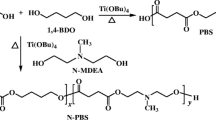Abstract
The influences of the temperature and the BDNPA/BDNPF (A3) content on the mechanical properties of and the binding energies between hexanitrohexaazaisowurtzitane (HNIW) and cellulose acetate butyrate (CAB)/A3 were studied via molecular dynamics simulations. The morphology of HNIW in acetone was simulated using an attachment energy (AE) model to elucidate the HNIW surfaces that are present under real-world conditions. The simulation results were consistent with the experimentally derived ones, and they indicated that the exposed HNIW surfaces were (0 0 1), (1 1 0), and (1 1 −1). The mechanical properties of CAB with different amounts of A3 were calculated at different temperatures, and the results showed that the amount of A3 was a stronger influence than the temperature on the mechanical properties. The binding energies between CAB/A3 and the exposed HNIW surfaces were calculated. Based on the binding energy and the area of each exposed surface, the weighted-average binding energy was calculated and then used instead of the total binding energy to evaluate the effect of the temperature and the A3 content on the binding energy. The average binding energy was found to be highest when the temperature was 313 K and the mass fraction of A3 was 0.15.








Similar content being viewed by others
References
Nielsen AT (1997) Caged polynitramine compound. US Patent 5693794
Lobbecke S, Bohn MA, Pfeil A (1998) Thermal behavior and stability of HNIW (CL-20). In: Proc 29th Int Conf of ICT, Karlsruhe, Germany, 30 June–3 July 1998
Vávra P (1999) Procedure for selection of molecular structures of explosives having high performance. In: Proc 30th Int Conf of ICT, Karlsruhe, 29 June–2 July 1999
Xiao J, Huang H, Li J, Zhang H, Zhu W, Xiao H (2008) A molecular dynamics study of interface interactions and mechanical properties of HMX-based PBXs with PEG and HTPB. J Mol Struct THEOCHEM 851:242–248
Xiao J, Ma X, Zhu W, Huang Y, Xiao H (2007) Molecular dynamics simulations of polymer-bonded explosives (PBXs): modeling, mechanical properties and their dependence on temperatures and concentrations of binders. Propell Explos Pyrot 32:355–359
Davande H, Bedrov D, Smith GD (2008) Thermodynamic, transport, and viscoelastic properties of PBX-9501 binder: a molecular dynamics simulations study. J Energ Mater 26:115–138
Sun YB, Hui JM, Cao XM (1995) Military use blended explosives. Weapon Industry Press, Beijing
Gibbs TR, Popolato A (1980) LASL explosive property data. University of California Press, Berkeley
Dong HS, Zhou FF (1989) High energy explosives and correlative physical properties. Science Press, Beijing
Zhu W, Xiao J, Zhu W, Xiao H (2009) Molecular dynamics simulations of RDX and RDX-based plastic-bonded explosives. J Hazard Mater 164:1082–1088
Wang DX, Chen SS, Jin SH, Shu QH (2016) Investigation into the coating and desensitization effect on HNIW of paraffin wax/stearic acid composite system. J Energ Mater 34:26–37
Xu X, Xiao J, Huang H, Li J, Xiao H (2010) Molecular dynamic simulations on the structures and properties of ε-CL-20(0 0 1)/F2314 PBX. J Hazard Mater 175:423–428
Xu X, Xiao H, Xiao J, Zhu W, Huang H, Li J (2006) Molecular dynamics simulations for pure ε-CL-20 and ε-CL-20-based PBXs. J Phys Chem B 110:7203–7207
Yu Y, Chen S, Li X, Zhu J, Liang H, Zhang X, Shu Q (2016) Molecular dynamics simulations for 5,50-bistetrazole-1,10-diolate (TKX-50) and its PBXs. RSC Adv 6:20034–20041
Rauch RB, Behrens R (2007) Vapor pressures, mass spectra and thermal decomposition processes of bis(2,2-dintropropyl)acetat (BDNPA) and bis(2,2-dinitropropyl)formal (BDNPF). Propell Explos Pyrot 32:97–116
Hobbs ML, Kaneshigea MJ, Erikson WW (2016) Modeling the measured effect of a nitroplasticizer (BDNPA/F) on cookoff of a plastic bonded explosive (PBX 9501). Combust Flame 173:132–150
Geiss D, Hicholich S, Mezger M, Hatch RL, Lee KE (1999) Additional characterization of high performance CL-20 formulation. In: Insensitive Munitions and Energetic Materials Technology Symp, Tampa, FL, USA, 29 Nov–2 Dec 1999, pp 129–140
Andersen HC (1980) Molecular dynamics simulations at constant pressure and/or temperature. J Chem Phys 72:2374–2383
Sun H (1998) An ab initio force-field optimized for condensed-phase applications overview with details on alkane and benzene compounds. J Phys Chem B 102:7338–7364
Ewald PP (1921) Evaluation of optical and electrostatic lattice potentials. Ann Phys 64:253–287
Zhao X, Shi N (1996) Crystal and molecular structure of ε-HNIW. Chin Sci Bull 41:574–576
Horst JH, Geertman RM, Rosmalen GM (2001) The effect of solvent on crystal morphology. J Cryst Growth 230:277–284
Liu N, Li Y, Zeman S, Shu Y, Wang B, Zhou Y, Zhao Q, Wang W (2016) Crystal morphology of 3,4-bis(3-nitrofurazan-4-yl)furoxan (DNTF) in a solvent system: molecular dynamics simulation and sensitivity study. CrystEngComm 18:2843–2851
Xiong S, Chen S, Jin S, Li L (2016) Additives effects on crystal morphology of dihydroxylammonium 5,5′-bistetrazole-1,1′-diolate by molecular dynamics simulations. J Energ Mater 34:384–394
Wang D, Chen S, Li Y, Yang J, Wei T, Li L (2015) Effect of solvent on the crystal morphology of royal demolition explosive. J Beijing Inst Technol 24:260–268
Berkovitch-Yellin Z (1985) Toward an ab initio derivation of crystal morphology. J Am Chem Soc 107:8239–8253
Watt JP, Davies GF, O’Connell RJ (1976) The elastic properties of composite materials. Rev Geophys Space Phys 14:541–563
Zhao Q, Liu N, Wang B, Wang W (2016) A study of solvent selectivity on the crystal morphology of FOX-7 via a modified attachment energy model. RSC Adv 6:59784–59793
Author information
Authors and Affiliations
Corresponding author
Electronic supplementary material
ESM 1
(DOCX 19 kb)
Rights and permissions
About this article
Cite this article
Lan, G., Jin, S., Wang, D. et al. Investigation of the effect of the CAB/A3 system on HNIW-based PBXs using molecular dynamics. J Mol Model 24, 186 (2018). https://doi.org/10.1007/s00894-018-3670-3
Received:
Accepted:
Published:
DOI: https://doi.org/10.1007/s00894-018-3670-3




